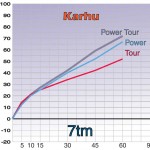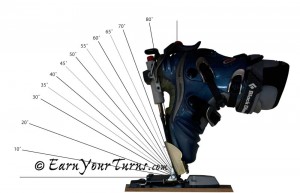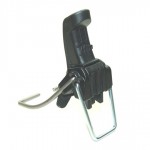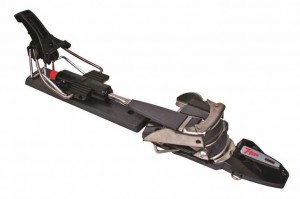When telemark skiing was approaching the apex of its popularity, the tribe knew we had best modify our gear or interest would wane. To that end the Holy Grail of telemark bindings was defined as one with lots of power for downhill control, a free-pivot for touring efficiency, step-in convenience, a safety release and, of course, light weight.
The 7tm Tour was the first to provide a free pivot with a safety release, but it has never developed much of a following due to it’s weight, price, and marginal power. However, for those who demand the safety release, the 7tm Power Tour is a binding to be seriously considered despite its relative weaknesses.Considering what it was developed for, backcountry skiing, the 7tm is hard to beat for its feature rich set of options.
For fat skis and aggressive styles, there are several other bindings that deliver more power. Nonetheless the Power Tour is plenty adequate for skis narrower than 90mm, and with a four-buckle boot and a bit of skill, provides enough mojo for 100mm wide skis. In addition, being a full 33m above the ski helps with angulation and edging power. Besides, it has a release and the more powerful 75mm bindings do not.
Consider the tour mode. 7tm was the first tele binding to offer it, and with a full 70°+ of frictionless motion, still more than any other 75mm telebinding. The pivot is 14mm in front of pin line which increased rotational inertia and makes the weight difference of the 7tm more noticeable even though the difference is mere ounces per foot. While certainly not optimal, but way better than no pivot, and hardly noticeable unless you compare it to the O1 side by side. The biggest bummer with the tour mode is you’ll probably have to bend over to switch modes. However, after three years of testing I never saw it ice up, which makes it much easier to overlook that inconvenience. It seems the rotational nature of the switch makes it self cleaning. With practice you may become adept at using your ski pole. I never did. I should also note, in moist conditions you may, nonetheless have some icing issues, usually a build up under the toe plate preventing the latch from catching.
Flipping your climbing bales is a pain if you try to crouch and flip it with your hand. Again, with a bit of practice you can use your ski pole. The key is a well aimed smack with the pole handle to flip the climbing peg down. By comparison, it is one of the more difficult bindings to switch modes or engage the climbing peg on.
If the power and mode switch seem a compromise you may be willing to overlook those short comings, especially if having a safety release is a requirement. Let me add, make that a reliable release, as in it doesn’t release prematurely, and seems to release when you need it to in combat mode. Perhaps that is merely a reflection of the value that comes from being the only DIN/TUV certified releasable telemark binding on the market, from DIN 4 – 11. Plus the ability to have a safety release allows you to forget about safety leashes since 7tm offers ski brakes.
Will it let go in an avy? Let’s just say you’ve got a heckuvalot better chance with this than, say, a suicide binding like the SuperLoop. However, in an avalanche you’re better to rely on an airbag pack than the safety release of your binding.
Two years ago 7tm completed offering all the features of telemark’s mythical grail in one binding by offering a step in heel latch. Unfortunately, like many other features of the 7tm, it works but has failed to generate any excitement. It does allow for relatively convenient entrance in to the binding. Unfortunately it takes a fair amount of adjusting before you obtain a tension that is both adequate for turning, yet allows for a modicum of step-in convenience.
It certainly isn’t as easy to get in as an alpine binding, or NTN. Besides, the step-in option costs an additional $47.50 and another 3 ounces of weight per foot. Although the standard heel lever of the 7tm is arguably the most difficult to use of all 75mm tele bindings, it’s not bad enough to justify the cost and weight of the step-in option. However, if you want it, it’s available.
7tm rounds out backcountry versatility by also offering optional crampons in two widths (85mm & 105mm), plus you have a choice of two climbing peg heights (30mm & 50mm).The 7tm mounts to the ski with a unique 5-hole pattern that doesn’t match anything else in the tele world. One of the nice side benefits of this binding is you can buy extra mounting plates for only $65 per pair and use the same toe plate on another pair of skis. Though it doesn’t allow the easy fore-aft adjustability of NTN’s swappable mounting plates, it is much easier to transfer the main binding assembly between skis.
One thing users get confused about is how to get back in to the binding when it releases. When it does so the toeplate stays on your boot. The easiest way to get back in is to place the toe in first, then weight the rear of the toeplate to get it to latch into the baseplate. (YouTube example here).
If release is important to you and you’re sticking with 75mm norm boots, 7tm is your only option. The release is good, the range of motion for touring awesome, and the power adequate. You can get a more powerful binding with other models, but you’ll have to either sacrifice release, or touring freedom. With sufficient technique, the power is plenty, especially when safety matters more.7tm Power Tour
(w/climbing bar, standard heel lever)
Price: $400
Weight/pair: 4 lbs., 1 oz. (65 oz / 1.83 kg)
7tm P2 Tour
(w/Step-in Heel, Climbing Bar)
Price: $430
Weight/pr: 4 lbs., 14 oz. (78 oz. / 2.21 kg)
Options:
Ski Brakes – $50 (widths available: 70mm, 83mm, 95mm, 110mm)
Step-In Heel – $47.50
Release Housing – $65.00 (functions as mounting plate for 2nd pair of skis)
Crampons – $75 (85mm), $85 (105mm)
© 2011
Related Articles:
Review of 7tm Power Tour from Couloir Online Dec. 2006
Review of 7tm Tour from Couloir XVIII-4, Dec. 05
Review of 7tm Tour from Couloir XVII-3, Dec. 04
7tm Power Tour FAQ





3 comments
1 ping
Another release option is std bindings with Telebry Safeouts. Wheeler publishes the torque data need for a release at each setting. Yeah, it adds weight and complexity but you can have a set on each ski pair and swap bindings between them as they’re drilled for all the common ones.
The drawback with the 7TM is that they don’t release forwards. I trashed a knee ‘cuz of this. Safeouts do release forwards.
Author
Good info. Have not been that intrigued by Telebry – not because it doesn’t work, but because of the extra weight and stack height it creates. But the forward release capability (or lack thereof in the case of the 7tm) is good info to know.
I have used 7TM binders in VT/NH and CO since the early versions (7-8yrs). In my share of mishaps the binding has released appropriately and in forward shear. I nearly dislocated a knee on the old G3, were it not for breaking the toe bar…my 7TMs popped off easily in the same tip-meets-big rock pow skiing scenarios.
[…] […]